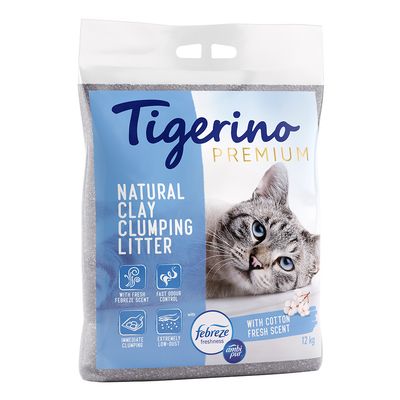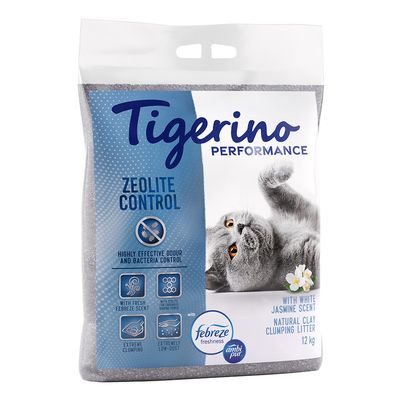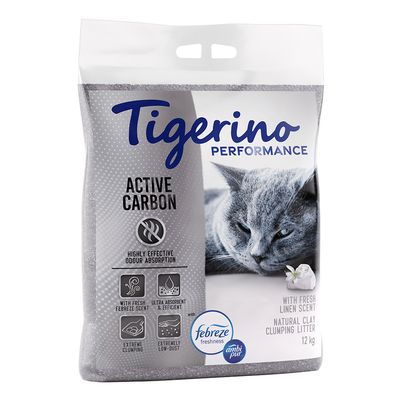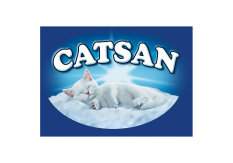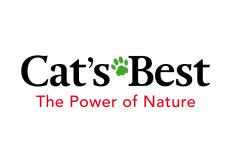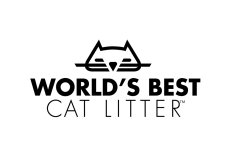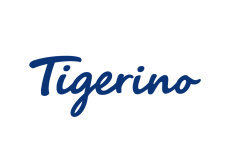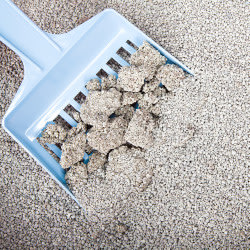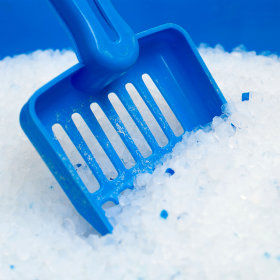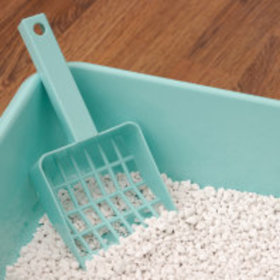Cat Litter
Tigerino Refresher Natural Clay Deodorant for Cat Litter
Spring Fresh (700g)
Delivery in 1-2 working days
Tigerino Premium Cat Litter - Febreze Cotton Fresh Scent
12kg
Delivery in 1-2 working days
Tigerino Refresher Natural Clay Deodorant for Cat Litter
Saver Pack: Fresh Cotton (2 x 700g)
Delivery in 1-2 working days
Breeder Celect Plus Probiotic Cat Litter
Economy Pack: 2 x 25l
Delivery in 1-2 working days
Ever Clean® Total Cover Clumping Cat Litter - Unscented
Economy Pack: 2 x 10l
Delivery in 1-2 working days
Sanicat Diamonds Aloe Vera
5 litre
Delivery in 1-2 working days
Tigerino Refresher Natural Clay Deodorant for Cat Litter
Fresh Cotton (700g)
Delivery in 1-2 working days
Super Benek Natural Cat Litter
10l (approx. 8kg)
Delivery in 1-2 working days
Intersand Classic Unscented Cat Litter
7kg
Delivery in 1-2 working days
Breeder Celect Plus Probiotic Cat Litter
25l
Delivery in 1-2 working days
World's Best Cat Litter Comfort Care
6.8kg
Delivery in 1-2 working days
Tigerino Performance Cat Litter Zeolite Control - Febreze White Jasmine Scent
Economy Pack: 2 x 12kg
Delivery in 1-2 working days
Biokat’s Diamond Care MultiCat Fresh Cat Litter
8l
Delivery in 1-2 working days
Tigerino Premium Cat Litter – Almond Milk & Honey Scent
12kg
Delivery in 1-2 working days
Breeder Celect Paper Cat Litter
10l
Delivery in 1-2 working days
Sanicat Vanilla Mandarin Clumping Cat Litter
8l
Delivery in 1-2 working days
Golden Grey
Economy Pack: 2 x 14kg
Delivery in 1-2 working days
Tigerino Nuggies Cat Litter – Cotton Flower Scent
14l
Delivery in 1-2 working days
Super Benek Compact Citrus Freshness Cat Litter
10l (approx. 8kg)
Delivery in 1-2 working days
Sanicat Classic Lavender Cat Litter
16l
Delivery in 1-2 working days
Tigerino Performance Active Carbon Cat Litter – Febreze Fresh Linen Scent
12kg
Delivery in 1-2 working days
Almo Nature Cat Litter
Economy Pack: 3 x 4.54kg
Delivery in 1-2 working days
Ever Clean® Total Cover Clumping Cat Litter - Unscented
10l
Delivery in 1-2 working days
Intersand Classic Unscented Cat Litter
Economy Pack: 2 x 7kg
Delivery in 1-2 working days
Which cat litter is the best option for your cat?
There are many types of cat litter to choose from, including clay, silica, wood pellets, and more natural alternatives such as recycled paper or plant-fibres such as corn litter. Each has unique qualities, so it’s worth exploring to see what suits your cat best.
To help you make an informed decision, here’s a quick overview of some of the most commonly used types of litter for cats:
| Litter Type | |
|---|---|
| Pros | Low-dust, lightweight, absorbs moisture effectively, lasts longer between changes. |
| Cons | Not biodegradable or flushable; some owners find odour control fades with extended use. |
| Litter Type | |
| Pros | Widely available, familiar texture, good short-term odor control, easy to clean, forms solid clumps. |
| Cons | Not eco-friendly, can be dusty, heavy, not suitable for flushing, can cause tracking. |
| Litter Type | |
| Pros | Affordable, absorbs moisture well, less dust than clumping, no need to scoop clumps. |
| Cons | Must be changed more often, less effective odor control, not eco-friendly. |
| Litter Type | Biodegradable & Plant-Based |
| Pros | Made from natural materials like paper, wood pellets or corn; eco-friendly; lightweight; often compostable. |
| Cons | Odour control varies, may need more frequent changes; some cats may be sensitive to the smell. |
| Litter Type | |
| Pros | Easy disposal, usually made from biodegradable materials, lightweight. |
| Cons | Varies in odor control and price; large quantities may clog plumbing. |
Litter Type | Pros | Cons |
|---|---|---|
Low-dust, lightweight, absorbs moisture effectively, lasts longer between changes. | Not biodegradable or flushable; some owners find odour control fades with extended use. | |
Widely available, familiar texture, good short-term odor control, easy to clean, forms solid clumps. | Not eco-friendly, can be dusty, heavy, not suitable for flushing, can cause tracking. | |
Affordable, absorbs moisture well, less dust than clumping, no need to scoop clumps. | Must be changed more often, less effective odor control, not eco-friendly. | |
Biodegradable & Plant-Based | Made from natural materials like paper, wood pellets or corn; eco-friendly; lightweight; often compostable. | Odour control varies, may need more frequent changes; some cats may be sensitive to the smell. |
Easy disposal, usually made from biodegradable materials, lightweight. | Varies in odor control and price; large quantities may clog plumbing. |
Note: No matter what type you choose, there are a number of things to consider about how to make and keep your cat’s bathroom clean. Check our cat litter how-to guide for advice on how best to cater to your cat’s needs.
Which cat litter is the best option for your cat?
There are many types of cat litter to choose from, including clay, silica, wood pellets, and more natural alternatives such as recycled paper or plant-fibres such as corn litter. Each has unique qualities, so it’s worth exploring to see what suits your cat best.
To help you make an informed decision, here’s a quick overview of some of the most commonly used types of litter for cats:
| Litter Type | |
|---|---|
| Pros | Low-dust, lightweight, absorbs moisture effectively, lasts longer between changes. |
| Cons | Not biodegradable or flushable; some owners find odour control fades with extended use. |
| Litter Type | |
| Pros | Widely available, familiar texture, good short-term odor control, easy to clean, forms solid clumps. |
| Cons | Not eco-friendly, can be dusty, heavy, not suitable for flushing, can cause tracking. |
| Litter Type | |
| Pros | Affordable, absorbs moisture well, less dust than clumping, no need to scoop clumps. |
| Cons | Must be changed more often, less effective odor control, not eco-friendly. |
| Litter Type | Biodegradable & Plant-Based |
| Pros | Made from natural materials like paper, wood pellets or corn; eco-friendly; lightweight; often compostable. |
| Cons | Odour control varies, may need more frequent changes; some cats may be sensitive to the smell. |
| Litter Type | |
| Pros | Easy disposal, usually made from biodegradable materials, lightweight. |
| Cons | Varies in odor control and price; large quantities may clog plumbing. |
Litter Type | Pros | Cons |
|---|---|---|
Low-dust, lightweight, absorbs moisture effectively, lasts longer between changes. | Not biodegradable or flushable; some owners find odour control fades with extended use. | |
Widely available, familiar texture, good short-term odor control, easy to clean, forms solid clumps. | Not eco-friendly, can be dusty, heavy, not suitable for flushing, can cause tracking. | |
Affordable, absorbs moisture well, less dust than clumping, no need to scoop clumps. | Must be changed more often, less effective odor control, not eco-friendly. | |
Biodegradable & Plant-Based | Made from natural materials like paper, wood pellets or corn; eco-friendly; lightweight; often compostable. | Odour control varies, may need more frequent changes; some cats may be sensitive to the smell. |
Easy disposal, usually made from biodegradable materials, lightweight. | Varies in odor control and price; large quantities may clog plumbing. |
Note: No matter what type you choose, there are a number of things to consider about how to make and keep your cat’s bathroom clean. Check our cat litter how-to guide for advice on how best to cater to your cat’s needs.
What to consider when choosing the right cat litter

Selecting the right litter for cats can make a big difference for both you and your cat. With many options available, from clay to plant-based and dust free cat litter, focusing on a few essential features can help you find the best fit:
- Odour control: Clumping litters and those with activated carbon mask odours well. Scented litters may appeal to owners but only use if your cat tolerates the fragrance.
- Dust levels: High dust can irritate sensitive cats and owners. Dust-free or pellet-based litters are often chosen by owners looking to reduce tracking and cater to allergies and sensitivities.
- Grain size and texture: Fine grains clump and mask odours better; coarser grains like wood pellets track less and suit long-haired cats or kittens.
- Ease of cleaning: Clumping litter allows spot scooping, while non-clumping requires full changes more often, especially for urine.
- Environmental impact: Plant-based litters (wood, corn or paper) tend to break down faster than clay and are often considered a more sustainable option by environmentally conscious owners.
- Value for money: Bulk buying benefits multi-cat households; eco-friendly or silica litters may cost more upfront but last longer.
- Cat preferences: Some cats prefer soft, sandy textures; others do better with coarser, low-dust, or unscented options.
- Accessories: Litter tray liners, mats, scoops, and cat litter deodorants can help reduce mess and ease cleaning.
What to consider when choosing the right cat litter

Selecting the right litter for cats can make a big difference for both you and your cat. With many options available, from clay to plant-based and dust free cat litter, focusing on a few essential features can help you find the best fit:
- Odour control: Clumping litters and those with activated carbon mask odours well. Scented litters may appeal to owners but only use if your cat tolerates the fragrance.
- Dust levels: High dust can irritate sensitive cats and owners. Dust-free or pellet-based litters are often chosen by owners looking to reduce tracking and cater to allergies and sensitivities.
- Grain size and texture: Fine grains clump and mask odours better; coarser grains like wood pellets track less and suit long-haired cats or kittens.
- Ease of cleaning: Clumping litter allows spot scooping, while non-clumping requires full changes more often, especially for urine.
- Environmental impact: Plant-based litters (wood, corn or paper) tend to break down faster than clay and are often considered a more sustainable option by environmentally conscious owners.
- Value for money: Bulk buying benefits multi-cat households; eco-friendly or silica litters may cost more upfront but last longer.
- Cat preferences: Some cats prefer soft, sandy textures; others do better with coarser, low-dust, or unscented options.
- Accessories: Litter tray liners, mats, scoops, and cat litter deodorants can help reduce mess and ease cleaning.
How often should I change the cat litter?
Used cat litter should be scooped daily. How often you replace the entire tray depends on the litter type. Some materials need changing every few days, others may last longer. Always follow the recommendations on the packaging and adjust based on how many cats use the tray.
Tip: A good rule of thumb is to scoop daily and monitor the smell. If it’s starting to smell or become visibly dirty, it’s time for a full refresh.
How often should I change the cat litter?
Used cat litter should be scooped daily. How often you replace the entire tray depends on the litter type. Some materials need changing every few days, others may last longer. Always follow the recommendations on the packaging and adjust based on how many cats use the tray.
Tip: A good rule of thumb is to scoop daily and monitor the smell. If it’s starting to smell or become visibly dirty, it’s time for a full refresh.
How much cat litter should I put in the box?
Most litter trays work well with about 3–4 cm of litter. Avoid overfilling, as too much litter can cause discomfort or make some cats reluctant to use the tray.
How much cat litter should I put in the box?
Most litter trays work well with about 3–4 cm of litter. Avoid overfilling, as too much litter can cause discomfort or make some cats reluctant to use the tray.




